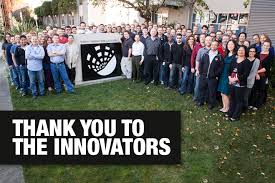 Skybox Imaging Inc. Team
Skybox Imaging Inc. Team
How to differentiate your disruptive and innovative company from the rest? Have your chief cheerleader (presumably your CEO) make an epic statement in which your entire company and your constituents can continuously hang their hats on.. The following is a classic example:
“We think we are going to fundamentally change humanity’s understanding of the economic landscape on a daily basis.” Skybox co-founder Dan Berkenstock
The above words from an entrepreneur whose offering is seemingly perceived to be something simple: satellite technology.
If you are an aspiring tech czar in the capital raising mode, a brand enhancement specialist, a venture capitalist doing due dili, or a mere investment banker who is working with an advanced-stage company whose execs are also looking to you to help ‘craft the value proposition” to investors, your target audience will always be more inspired when you perspire passion to the point where its dripping from your pores.
The context of the above quote is in connection with a very compelling piece written by WSJ reporter Christopher Mims in his aptly-titled column “KEYWORDS”
Below are select extracts from the June 16 WSJ article: The story itself is not merely about enterprise valuation techniques and not only about the next great technology innovation, the story transcends borders for those who can read in between the lines..
Silicon Valley lately has seemed like the land of wild—or at least puzzling—valuations.
Facebook bought WhatsApp, a messaging service with paltry revenue and at least a half-dozen sophisticated competitors, for $19 billion. Uber was just valued at $18.2 billion in a round of private-equity financing. Even Beats Electronics, a company with a music service in its infancy and technologically inferior headphones that could fall out of fashion at any moment, was valued at $3.2 billion to Apple.
But Google just bought a company that could have a bigger impact on its bottom line and on the world than any other recent acquisition by the search giant or its tech brethren—for just $500 million.
For 1/38th the price of WhatsApp, Google acquired Skybox Imaging, which puts satellites into orbit 185 miles above Earth on the tip of the same Russian missiles that once threatened the U.S. with nuclear destruction. And here’s what Skybox could allow Google to accomplish: Within a couple of years, when you want to know whether you left your porch light on or if your teenager borrowed the car you forbade her to drive, you might check Google Maps.
That’s because by 2016 or so, Skybox will be able to take full images of the Earth twice a day, at a resolution that until last week was illegal to sell commercially—all with just a half-dozen satellites. By the time its entire fleet of 24 satellites has launched in 2018, Skybox will be imaging the entire Earth at a resolution sufficient to capture, for example, real-time video of cars driving down the highway. And it will be doing it three times a day.
And yet, as I discovered when I visited Skybox recently at its modest, low-slung headquarters in Mountain View, Calif., satellite imagery isn’t even the business in which the company’s founders see themselves. As at Google, the business of Skybox isn’t data, but knowledge.
“We think we are going to fundamentally change humanity’s understanding of the economic landscape on a daily basis,” says co-founder Dan Berkenstock.
Here’s an example of what he’s talking about. In 2010, an analyst at UBS discovered that if he bought satellite images of parking lots of Wal-Mart stores, he could predict the company’s sales figures before they were revealed in its quarterly report, because cars in lots equal shoppers in stores.
“We’re looking at Foxconn every week,” Mr. Berkenstock says, because measuring the density of trucks outside the Taiwanese company’s manufacturing facilities tells Skybox when the next iPhone will be released.
Skybox can determine how much oil is being pumped out of the ground in Saudi Arabia by imaging oil-storage tanks from above. The company can peg the likely price of grain months in advance by measuring the health of every square yard of cropland on Earth. One city has used Skybox’s data to determine who built illegal backyard pools and might use it to identify water-restriction violators during a drought.
It’s competitive intelligence as spy craft. And it’s compelling enough that a Skybox employee once told a reporter for Wired that the company might someday simply become an unreasonably profitable hedge fund.
Yet these known uses of satellite data—which have never been available in the abundance that Skybox says it can achieve—are just the beginning. It’s the unpredictable applications that could be the biggest.
If Google can get a cut of those services by charging a licensing fee for the underlying data, it could be a new business that might move the needle on Google’s revenue mix, which, ample as it is, remains stubbornly linked to search advertising.
Case Study for Corporate Marketers, Bankers, Branding Gurus and PR Positers: Skybox Inc








